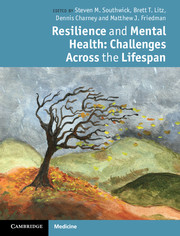Book contents
- Frontmatter
- Contents
- Contributors
- Preface
- Section 1 Pathways to resilience
- Neurobiology of resilience
- 2 Resilience in the face of stress: emotion regulation as a protective factor
- 3 Cognitive factors and resilience: how self-efficacy contributes to coping with adversities
- 4 Personality factors in resilience to traumatic stress
- 5 Social ties and resilience in chronic disease
- 6 Religious and spiritual factors in resilience
- Section 2 Resilience across the lifespan
- Section 3 Resilience in families, communities, and societies
- Section 4 Specific challenges
- Section 5 Training for resilience
- Index
- References
6 - Religious and spiritual factors in resilience
from Section 1 - Pathways to resilience
Published online by Cambridge University Press: 07 September 2011
- Frontmatter
- Contents
- Contributors
- Preface
- Section 1 Pathways to resilience
- Neurobiology of resilience
- 2 Resilience in the face of stress: emotion regulation as a protective factor
- 3 Cognitive factors and resilience: how self-efficacy contributes to coping with adversities
- 4 Personality factors in resilience to traumatic stress
- 5 Social ties and resilience in chronic disease
- 6 Religious and spiritual factors in resilience
- Section 2 Resilience across the lifespan
- Section 3 Resilience in families, communities, and societies
- Section 4 Specific challenges
- Section 5 Training for resilience
- Index
- References
Summary
Introduction
This chapter will examine how religion/spirituality plays an important role as a resource used by most people in coping with the immediate, as well as longer-term, consequences of highly stressful or traumatic experiences. First, working definitions of the key concepts of resilience and religion/spirituality will be given. Distinctions are made between definitions for general communications and operational definitions suitable for clinical and research purposes. Spirituality is conceptualized as a dynamic process that is an integral and inseparable part of humanity. A current conceptual model of spirituality as being multidimensional in nature is presented, and core dimensions are described. Findings from a selective review of current studies on religion and/or spirituality and resilience are presented. Four key obstacles, or “spiritual red flags,” are identified, and a group therapy module for addressing them is presented. Finally, conclusions about our current knowledge, as well as recommendations for future clinical and research applications are made.
Spirituality is acknowledged as an important part of life by most individuals. Annual Gallup polls consistently show that more than 90% of the US population report a “belief in God,” and approximately 70% report affiliation with a faith community and attending religious services. In addition, religion or spirituality has been consistently linked to positive mental (Nooney & Woodrum, 2002) and physical (Powell et al., 2003) health functioning, as well as increased longevity (Oxman et al., 1995). When mental health services are sought, clergy are most frequently the first point of contact, with more than 40% seeking counseling from them rather than mental health providers (Weaver et al., 1997). In the immediate aftermath of the terrorist attacks of September 11 2001, more than 90% of those surveyed reported that they coped by “turning to religion,” second only to “talking with others,” which was endorsed by 98% (Schuster et al., 2001). However, despite the widely recognized positive aspects of religion or spirituality, there are large gaps in our scientific knowledge of the dynamic processes of spirituality that could explain these relationships.
- Type
- Chapter
- Information
- Resilience and Mental HealthChallenges Across the Lifespan, pp. 90 - 102Publisher: Cambridge University PressPrint publication year: 2011
References
- 5
- Cited by

